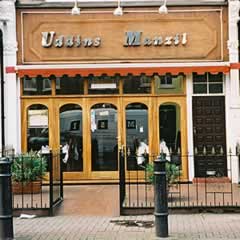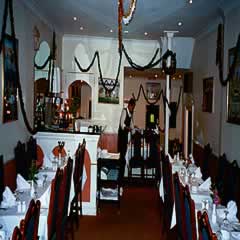|
Uddin Manzil 194 Wandsworth Bridge Road, Fulham, SW6 2UF Tel: 020 7736 3584/7731 1090 | 
|
|
|
The Cuisine |
||||
|
Indian Cooking is known for its use of spices, herbs and flavourings. The dishes from this country range from mild creamy kormas to the hot curries of the south. The most common ingredient is the perfect blending of the spices to the right proportions so that each of the dishes have a distinct flavour. Indain dishes including sweetmeats are seldom cooked without spices. The most commonly used spices for the sweetmeats are elaichi[cardamom] and/or kesar[saffron]. A special way of serving both savoury and sweets is to use Varq or edible beaten silver leaf. Another item that is largely used in the Indian cooking is called "Ghee" which is nothing but melted butter. Rubbed into meat and made into masalas by combining with cream, yoghurt or coconut milk makes it blend into a rich smooth sauce with spices especially applicable to the authentic Indian cooking. For best results try to get the fresh spices and grind them when you need them, thus preserving their aroma & flavour. Many Indian dishes owe their fiery flavour to the chillies, ginger and garlic. A typical Indian meal in the south may consist of rice, one or two vegetable dishes, a spicy hot chutney and a curry. A typical north Indian meal may include rotis or parathas, a meat dish, one or two vegetable dishes, a dhal and yoghurt. Due to the variety in culture, each state has developed its own way of preparing dishes especially with variety in rie based items. Typically long grain rice is used on a daily basis, but speciality items of rice is made with a special aromatic rice called Basmati. Another common variation to the Indian cooking is the "Mughalai Khaana", which is the food that was eaten and relished by the Indians during the Mughal period in the Indian history. It lays stress on good ingredients, low flame cooking and rich spices. Ingredients such as Badam[almonds], Khus-Khus[poppy seeds] and flavouring spices such as Elaichi[cardamom], Dalchini [Cinnamon], Laung[cloves], Jaitri[mace] and Jaiphal[nutmeg] are used to prepare Mughalai food. Curds and cream form the gravies having less stress on tomatoes. Onions are usually deep fried to a golden brown colour and then blended to a paste and used in the gravies. Kebabs are the speciality of Mughalai cooking and served as snacks as well as meal time accompaniments. Rice preparations such as Biryani holds a special place in Mughalai food. |
||||
| The Chef |  |
The Restaurant | ||
| The Chefs very authentic delights have been enjoyed at this restaurant for the last 15 years, his skills enable him to adapt the variety to suit all and is highly acclaimed in the local area. A fresh Sunday buffet is available in this enjoyable and very friendly restaurant |
This family run business, has for the last six years, been serving a wide selection of authentic Indian cuisine's The many traditions of Indian food are served here all prepared fresh to order. (please see our menu)The pleasant surroundings and cosy and relaxing environment allows you to dine at your leisure enjoying a full evening of dining and feasting. |
|||
